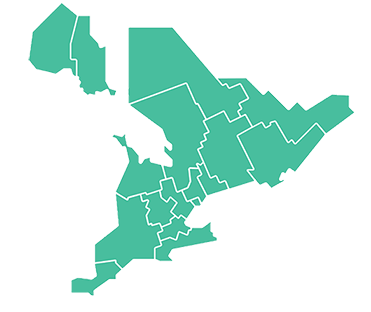NEW GRAD TOOLKIT
OPA is here to help with each stage of your career. We asked students and new graduates to identify what would be important and useful to them as they began their professional practice. Their recommendations formed the basis of this New Graduate Kit.
Contact us with any suggestions for this Toolkit.
New Grad Checklist:
Renew CPA/OPA membership in September
Login and change your membership category to “New Grad” & receive a 50% discount on your first paying year as a member.
Professional Liability Insurance
All registered physiotherapists require Professional Liability Insurance to practice. The CPA offers a Professional Liability Insurance program tailored specifically for PTs through BMS Group.
Get involved in your local OPA District.
OPA is divided into 16 geographic districts across the province.
Register to Practice
All physiotherapists must register with the College in order to practice in the province. Visit the College for detailed information about the registration process.
Getting an Interview
Update your LinkedIn profile and review your social media presence to ensure they reflect a professional profile. Employers may check you out on social media before they decide to offer you an interview.
Interview Tips
- Regardless of the setting, wear professional attire.
- Make sure you’ve done research on the employer/organization; select employer/organizations that align with your own values.
- Find out who will be on your interview panel and do some background research on each panelist.
- Interviews often contain scenarios of clinical situations. Practice scenarios before the interview.
- Bring a copy of your cover letter, CV and references. Give your references notice about the specific position for which you are interviewing and inform them that they might be contacted
Ask questions at the end of the interview to show your interest in the position:
- How would you describe the working environment?
- What do you like most about working here?
- How is mentorship provided within the organization?
- Are there internal professional development opportunities? Is there financial support for these?
- Whatever else is important to you!
- For private practice/clinic-based interviews, make sure prospective employers are aware of your standards of practice and obligations for meeting those standards especially when it comes to billing practices
- Ask questions like:
- What is the process for you to be able to review financial records where your registration number is being used?
- Has the clinic/company taken any steps to help protect employees and/or patients from fraudulent billing?
Choosing Your Employment Status
Self-Employed Vs. Employee
Deciding whether you want to be self-employed (independent contractor) or an employee is an important step as you start looking for a position. There are advantages and disadvantages to both. Knowing yourself, what you want and what is important to you with respect to work/life balance will help you understand your options.
It is not uncommon for a PT to be hired as an independent contractor but then find within the contract/agreement and/or as they start to practice at a clinic, that they are actually receiving benefits like their employee colleagues or friends. Don’t confuse the employment relationship! Don’t let the Canada Revenue Agency be the ones to tell you that you are not an independent contractor. Know the difference and maintain the distinction.
MORE INFORMATION
Check out additional information from CPA about self-employment versus being an employee.

Employment Status Tips
If you are accepting a position as an employee, make yourself aware of the employer’s expectations and your rights as an employee. For example: Notice of termination, vacation and sickness pay, remuneration, meal breaks, overtime, maternity leaves, holidays, emergency leaves, severance, etc.
Employees should be aware of any probationary periods and what benefits they are entitled to during that time or at which point they come into effect.
If you are a independent contractor, maintain an individual business profile. This includes marketing yourself, having a separate office, providing invoices to the payer, and not attending staff functions.
Contractors must either provide their own tools and workspace or pay the owner for rental and lease of what is provided. This should be a flat, monthly fee separate from work pay.
Education allowances can only be offered to employees and not contractors. If one is offered to you as a new employee, ask how it may used, if there is an expiration date, and how it is applied (i.e. does the clinic owner pay for the course or will you be reimbursed).
It is important to be aware of the Employment Standards Act (ESA) and how it may, or may not, apply to you and your employment terms and conditions. For example, under the ESA, most professionals regulated at the time the legislation was initially passed, including physiotherapists, are exempt from various sections within the statute. The reasoning at the time related to the diverse work settings for professionals, their ability to negotiate their own work circumstances and the preeminence of the regulatory colleges in setting practice standards. The sections from which physiotherapists and other regulated professionals are exempt include hours of work, overtime, minimum wage, vacation and pay.
Physiotherapists who are employees and are part of a union may have some of these exemption areas addressed as part of their collective agreements. If you are an employee, it may be a good idea to discuss these areas of exemption with your employer to ensure that appropriate provisions are included in some of agreement, contract or organizational policy.
The ESA does not apply to independent contractors.
Physiotherapists in Ontario who are employees in organizations under federal jurisdiction, such as the Canadian Forces, the RCMP, broadcasting, telecommunications, chartered banks and Veterans Affairs, are subject to the Canada Labour Code and not the ESA. The Canada Labour Code deals with matters such as hours of work, leave, holidays, sexual harassment and employment termination.
Please note that the above information does not constitute legal advice. If you have questions regarding employment contracts, you are encouraged to contact an employment lawyer to assist you in making informed decisions.
To learn more about Employment Standards and/or the ESA, please visit the Ontario Ministry of Labour website.
LETTER OF OFFER/CONTRACTS
Offer letters/contracts will look different depending on the organization/practice setting and employment status. However, core elements such as the position/role, salary, benefits, probation, termination, and performance management should be addressed in all agreements.
- Read the letter/contract carefully to ensure it is the same information as discussed in your interview.
- If the information is different, do not sign until you have addressed any discrepancies. If there is something you don’t understand, ask for clarification.
- Consider having a lawyer review the letter/contract.
- If you are being offered a benefits package, ask for a copy to review.
- Always keep a copy of anything that you have signed.
PERFORMANCE APPRAISAL
Usually an employer conducts a performance appraisal after your probation period. You need to know what the appraisal is based on, who will conduct it
and how often you will have additional appraisals. Performance appraisals are often tied to changes to your compensation.
The College of Physiotherapists of Ontario has additional information for new grads to consider before accepting an offer.
COMPENSATION
Compensation for your new position will depend on many factors like what sector you are working in and whether you are working as an employee or an independent contractor.
HOW MUCH WILL I GET PAID?
There are many ways your income might be determined including hourly wage, annual salary, or percentage of clinic revenue. The payment structure will often depend on your employment status. For example, independent contractors do not get an annual salary but are often paid on a per-patient or per-hour basis.
Research the market in your area for physiotherapists with your qualifications and evaluate their worth to employers. Consider also:
- Are there bonuses or incentives included in your contract?
- Are you paid if your client cancels?
If your employer does not remove income tax, you may end up paying $10,000- $20,000 at the end of the year in income tax. Consider paying in instalments. Find an accountant who works with health care professionals to help you.
MORE THAN MONEY
Compensation is not just about how much you get paid so know what will be included in your compensation. Compensation packages that include benefits, paid vacation etc. are more common in full-time positions rather than part-time positions and are not available to independent contractors.
BENEFITS
Are benefits included in your salary or do you receive a percentage “in lieu” of benefits? You should investigate whether or not a private health insurance plan may be a better option for you. Often contract employees in private practice do not receive benefits. This can also be the case for contract positions in hospitals as well.
VACATION
Common vacation allowance is usually 2-4 weeks per year, but you will need to confirm, and potentially negotiate this. Is it paid vacation? Often you accrue your vacation with each pay period so it may be a few months. Choice in vacation time may be based on seniority. As a new staff person, you may not get your first pick of holidays.
If you have already planned a post-graduation celebratory holiday that may impact your start date, be honest with your employer and let them know this before you finalize the letter of offer/contract.
LONG TERM DISABILITY
What’s covered and how much coverage do you receive and over what period of time? You will only be covered for the length of your employment. If you work at a clinic and a hospital you would need coverage from two different long-term disability plans.
SICK LEAVE
Do you have a certain number of paid sick days per year?
EXPENSES
Does the employer support continuingprofessional development? Do you have paid educational leave days?
Is there an education fund that you can apply to when taking courses, or does the organization pay for you to attend? Will you be reimbursed for technology used as part of your practice? Does the organization pay your association and/or college dues?
As you start to apply for physiotherapist positions, knowing what average salaries are for entry level positions and what benefits are common is helpful to manage your expectations while you engage in negotiations with respect to compensation with potential employers. In 2018, OPA surveyed members to evaluate compensation across all practice settings in Ontario. The full results are available on the OPA website and contain additional detailed information regarding physiotherapists in each sector, including what geographical areas they are from, their employment status (e.g. full time/part time), and other compensation information (e.g. paid vacation, health insurance etc.).
The following indicates the most commonly earned salary by sector for the subset of respondents practicing five years or less based on a 1.0 full time equivalent (FTE):
HOSPITAL: Equal number of respondents reported earning between $60,000-$69,999 and between $70,000-$79,999
PRIVATE PRACTICE: Most common response for this subset reported earning between $60,000-$69,999
PRIMARY CARE: Most common response in our subset reported earning between $70,000-$79,999
Due to a low response rate for long-term care and home care, please see the full report for compensation information.
Promoting Your Profession
OPA promotes the profession to the public in year round digital campaigns. In 2022 the #PhysiotherapyMatters campaign reached Ontarians with video stories from patients – reaching Ontarians through Facebook and YouTube video ads and posts on social media.
We continue to highlight PTs and PTAs as health care professionals that are safely and effectively providing care in-person and/or virtually. Check out the campaign website discoverphysiotherapy.ca.
OPA has created a special program for students, new grads, those who have been practicing for five years or less, and internationally educated physiotherapists who are new to practice in Canada called New to Practice (N2P). This program includes:
- One hour mentorship/coaching sessions with experts on specific topics relevant to this cohort of our membership.
- Sharing of resources/tools by the coaches on the topic presented to compliment the session.
- An opportunity to ask questions and have the coaches respond via email for at least one month following the coaching session.
Check out past coaching calls recordings, resources, and announcements of upcoming coaching calls for 2022.
Member volunteers are essential to the work and vision of the Ontario Physiotherapy Association. They provide their experience, expertise and passion to support and strengthen the Association and the profession. OPA’s leadership and staff provide volunteers with ongoing support to ensure that volunteers are confident and successful in their roles. OPA members have access to meaningful volunteer opportunities and resources that help them, not only throughout their volunteer involvement with the Association, but in their continued growth and development as leaders in the profession.
Join a Committee
Eight OPA committees provide vital links between members, the OPA Board of Directors and the Association as a whole. All committees receive staff support and report directly to the Board of Directors.
Joining an advisory committee is a great way to be a leader within your physiotherapy community and contribute to the work of your Association. It will also help you be more informed about current and future changes within the health system. To learn more, or to join an OPA committee, please contact Aleksandra Nikolovski. The eight committees are:
- Governance
- Finance
- Awards
- Education
- Hospital Advisory (HAC)
- Home Care Advisory (HCAC)
- Primary Care Advisory (PCAC)
- Private Practice Advisory (PPAC)
OPA has 16 geographical districts which are critical to ensuring the Association has a broad base of support, and that members can bring the unique perspective of local health issues and professional matters to the provincial level. Each district has a District President/liaison and a District executive who are responsible for planning events and providing additional feedback and input to the OPA Board and staff. Being active in your District provides you with a great opportunity to network with your peers and be a part of a larger PT community. Often, Districts organize courses that can help you grow your career.
The Ontario Physiotherapy Association (OPA) is a non-profit organization whose members are physiotherapists, physiotherapist assistants and students living and/or working in Ontario. Our mission is to provide leadership, support and advocacy for members so that Ontarians can access quality physiotherapy services when and where they need it. With more than 6,000 members across the province we are a strong voice for the profession and the largest provincial branch of the Canadian Physiotherapy Association.
OPA’s Long Term Goal for 2022-2024: Physiotherapy will accessible to all Ontarians, across their lifespan, as an essential part of healthy communities, quality of life and function.
Read the 2021 OPA Annual Report to learn more about what OPA achieved last year.
OPA’s leadership in advocacy has led to greater opportunities for the profession and for new grads, such as yourself. We look forward to your continued membership and welcome you to join us in support of our mission, vision and values.
CONTACT US
We are here to help.
Find out more about all OPA staff
and contact us with any questions.




